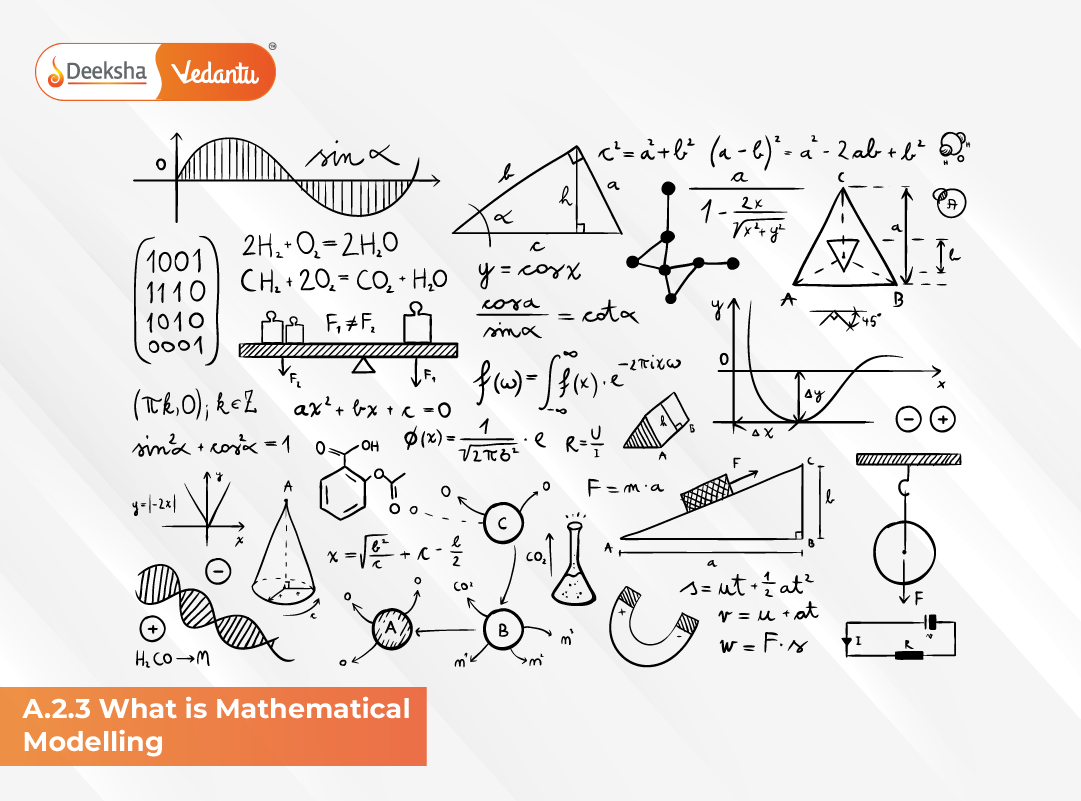
Introduction
Mathematical Modelling is the art and science of translating real-world situations into mathematical language. It involves using equations, graphs, and logical reasoning to represent complex systems such as population growth, projectile motion, heat transfer, or economic trends. For JEE aspirants, understanding mathematical modelling builds strong problem-solving and analytical thinking skills essential in both Mathematics and Physics.
A mathematical model bridges the gap between the real world and the mathematical world. It provides a simplified but effective description of how systems behave, allowing predictions, analysis, and optimization.
Definition
A mathematical model is a mathematical representation (such as an equation or inequality) that describes a real-world situation. It involves:
- Identifying the problem
- Formulating it mathematically
- Solving the resulting equations
- Interpreting the solution in real-world terms
In simple terms, mathematical modelling helps us answer “What happens if…?” questions using mathematics.
Purpose of Mathematical Modelling
The goal of mathematical modelling is to make sense of reality using mathematics. It helps to:
- Predict future outcomes (e.g., population growth, motion of a projectile).
- Understand underlying mechanisms (e.g., rate of cooling, spread of disease).
- Optimize performance (e.g., minimizing cost, maximizing profit).
- Test hypotheses and refine them using data.
In the JEE context, this understanding aids in applying mathematical principles to engineering, physics, and data analysis.
Steps in the Mathematical Modelling Process
A systematic process ensures clarity and precision in developing a model:
1. Problem Identification
Define what is being studied. Example: How does a ball move under gravity? How does a bacteria population change over time?
2. Simplifying Assumptions
Simplify complex reality. Example: Ignore air resistance or assume uniform gravity.
3. Defining Variables and Parameters
Identify measurable quantities like time (t), position (x), or growth rate (k).
4. Constructing Mathematical Relationships
Build equations that connect variables, e.g. v = u + gt or P(t) = P₀e(kt).
5. Solving the Model
Use algebraic, differential, or numerical methods to find solutions.
6. Interpreting the Results
Translate mathematical outcomes into real-world meaning.
7. Validating and Refining the Model
Compare with experimental or observed data to confirm accuracy.
Example 1: Projectile Motion
A body thrown with velocity u at an angle θ follows a parabolic path. The equations of motion are:
x = u cosθ * t
y = u sinθ * t – (1/2) g t²
This model helps predict range, time of flight, and maximum height — key concepts in JEE Physics.
Example 2: Exponential Population Growth
Population growth proportional to its current size can be written as:
dP/dt = kP
Solving gives:
P(t) = P₀ e(kt)
This model helps analyze biological and environmental growth phenomena.
Example 3: Cooling of a Hot Body
According to Newton’s Law of Cooling:
dT/dt = -k (T – Tₐ)
Solving gives:
T(t) = Tₐ + (T₀ – Tₐ)e(-kt)
This equation predicts how quickly an object cools in a surrounding environment.
Types of Mathematical Models
Mathematical models can be categorized based on their nature:
| Type | Description | Example |
| Deterministic | No randomness; output is fully determined by inputs | Motion of a projectile |
| Stochastic | Includes random elements | Stock market fluctuations |
| Static | Describes a single state | Force balance in a structure |
| Dynamic | Changes over time | Population or heat flow |
| Linear | Variables related linearly | y = mx + c |
| Non-Linear | Involves higher powers or products of variables | y = ax² + bx + c |
Importance in JEE Preparation
Mathematical modelling integrates multiple JEE topics such as:
- Kinematics and Calculus – for motion equations and rate of change.
- Differential Equations – for growth and decay processes.
- Optimization Problems – for maxima and minima in applied scenarios.
- Probability Models – for predicting uncertain outcomes.
It enhances logical problem-solving by helping students identify what kind of mathematics applies to what type of real-world problem.
Marks Weightage in JEE
| Exam | Topic | Average Weightage | Difficulty Level |
| JEE Main | Basics and Applications | 2–3 Marks | Easy to Moderate |
| JEE Advanced | Complex Modelling & Real-World Analysis | 4–6 Marks | Moderate to High |
Advantages of Mathematical Modelling
- Provides quantitative understanding of real phenomena.
- Enables prediction and control of processes.
- Simplifies complex systems into manageable equations.
- Allows simulation and optimization before real implementation.
- Bridges theoretical and experimental studies.
Limitations of Mathematical Modelling
- Simplified assumptions may reduce accuracy.
- Errors in data can mislead predictions.
- Non-linear or chaotic systems may be difficult to model.
- Validation issues arise when data is insufficient.
JEE-Based Problem Example
Problem:
The temperature of an object decreases according to Newton’s Law of Cooling. If its initial temperature is 80°C and surrounding temperature is 30°C, find the time when the temperature becomes 50°C, given k = 0.1 min⁻¹.
Solution:
T(t) = 30 + (80 – 30)e(-0.1t)
50 = 30 + 50e(-0.1t)
→ e(-0.1t) = 0.4 → t = (ln(1/0.4))/0.1 ≈ 9.16 minutes.
FAQs
Q1. What is mathematical modelling in simple terms?
It is the process of describing real-world problems using mathematical equations and logic.
Q2. Why is it important for JEE aspirants?
It connects physics, mathematics, and real-world reasoning — essential for solving application-based problems.
Q3. What are the stages in modelling?
Defining the problem, simplifying, forming equations, solving, interpreting, and validating.
Q4. What mathematical tools are used in modelling?
Calculus, algebra, geometry, statistics, and differential equations.
Q5. Can all real-world phenomena be modelled mathematically?
Not perfectly, but approximate models can still provide valuable insight and predictions.
Conclusion
Mathematical Modelling is a cornerstone of applied mathematics that transforms real-life problems into solvable mathematical structures. It builds analytical thinking, precision, and creativity — essential traits for JEE aspirants. Whether it’s the motion of a particle or the spread of heat, models reveal the underlying mathematical beauty of nature and technology. Mastering this concept prepares students to tackle interdisciplinary challenges confidently in engineering and beyond.






Get Social